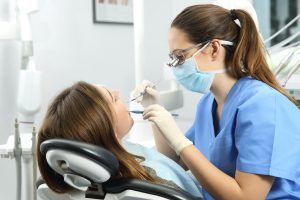 Author: Nicky Varney – Head of Marketing Eschmann
Author: Nicky Varney – Head of Marketing Eschmann
Setting up a squat practice or taking over an established one both present many challenges. For the new principal, there are staff to meet, accounts to assess, contracts to review, premises to update, and changes to make, all while seeing new patients and delivering first-class dental care. The health and safety of everyone in the building is a priority and should be the first aspect considered when getting to grips with the business.
Patient safety

To ensure patients are protected from avoidable infection, it is critical to evaluate the decontamination processes in place and to establish rigorous protocols. Even one small error – anywhere in the practice – could enable opportunistic bacteria to infect someone. Those who are immunocompromised or other vulnerable people are at greater risk.[i]
For example, there must be a clear dirty-to-clean workflow, ensuring professionals can keep the two strictly segregated. It is also important to implement processes specific to each area of infection control and prevention, each clearly defining what must be done, when, how, by whom, and with what.
This covers hand hygiene, surface cleaning and disinfection, and instrument sterilisation, with considerations for both professionals and patients to fulfil their respective responsibilities. Regarding the former, it should not be assumed that all members of the team are familiar with the necessary steps, and training should be delivered to all those new to the practice. Refreshers are also very helpful even for experienced professionals, and going back to basics is especially useful if changes are being made to their previous workflows.
When it comes to patient education, simple posters located strategically around the practice will remind individuals of the need for meticulous hand hygiene and what this entails. In appropriate situations, such as pre-surgical appointments, patients might also be advised to use an antimicrobial mouthwash to reduce the risk of microbial contamination in aerosols.[ii]
Professional protection
While all of the above will reduce the risk of infection among staff as well as patients, additional steps must be implemented to further protect the team. A specific protocol must be designed for sharps management and disposal, for example. Professionals are at potential risk of more than 40 bloodborne infections from sharps injuries, including Hepatitis B and C, and HIV. Safe sharps practices, such as banning of recapping, are key.[iii]
Similarly, the management of all clinical waste – including waste sharps – must be carefully considered. Approximately 15% of the total waste generated in healthcare facilities worldwide is estimated to be hazardous, presenting infectious, toxic or radioactive risks to people and the environment.[iv] All waste items generated in the dental practice must be handled and discarded in line with HTM 07-01,[v] including the use of appropriate bags and containers. The Department of Health’s best practice guidelines also recommend colour-coding waste according to the risk it presents, separating clinical infectious, clinical highly infectious, offensive, medicinal, cytotoxic and cytostatic, anatomical, dental amalgam and gypsum, and mixed municipal waste. Staff must know how to achieve this while protecting themselves and their colleagues from potential harm.
Only as good as the tools at hand
However, excellent professional training and meticulous workflows alone are not enough to keep everyone safe in the dental practice. The equipment utilised throughout the decontamination process must also be reviewed to ensure that it too meets the necessary regulations and fulfils all relevant legal obligations.
Focusing on the autoclave, whether you are buying a new machine, have inherited the equipment upon practice purchase or you installed a second-hand machine, it is crucial that you do not simply use it without getting it checked. A compromised autoclave could lead to insufficient instrument sterilisation and increased running costs, as well as having a detrimental impact on your practice should a patient or team member be unknowingly exposed to infectious agents.
Rather than leaving things to chance, make sure to have the equipment fully checked, tested and validated before using it, and annually thereafter. The former will ensure it is functioning correctly, facilitating workflow efficiency and optimising safety standards. Annual validation including the PSSR testing which is a legal requirement for compliance and includes a Pressure Systems Safety Regulations (PSSR) certificate.[vi]
For complete peace of mind, put your faith in an Eschmann autoclave and the comprehensive Care & Cover maintenance and servicing programme. With a nationwide team of expert engineers trained specifically on Eschmann equipment, we offer equipment testing, servicing and validation, with annual Enhanced CPD staff training included with our equipment as standard. That means you can be confident in the quality of your decontamination protocols for the health and safety of patients and staff alike.
Peace of mind
Safety standards are not an option in the dental practice, they are the foundation on which excellent dental care are built. There is much to consider when setting up a new practice or purchasing an existing business, but safety always comes first.

For more information on the highly effective and affordable range of decontamination solutions available from Eschmann, please visit www.eschmann.co.uk or call 01903 753322
[i] Bytyci J, Ying Y, Lee LYW. Immunocompromised individuals are at increased risk of COVID-19 breakthrough infection, hospitalization, and death in the post-vaccination era: A systematic review. Immun Inflamm Dis. 2024 Apr;12(4):e1259. doi: 10.1002/iid3.1259. PMID: 38661301; PMCID: PMC11044684.
[ii] Saini RS, Binduhayyim RIH, Mosaddad SA, Heboyan A. Strategies for preventing aerosol-generated microbial contamination in dental procedures: A systematic review and meta-analysis. Am J Infect Control. 2025 May;53(5):638-647. doi: 10.1016/j.ajic.2025.02.001. Epub 2025 Feb 7. PMID: 39924000.
[iii] De Carli G, Abiteboul D, Puro V. The importance of implementing safe sharps practices in the laboratory setting in Europe. Biochem Med (Zagreb). 2014 Feb 15;24(1):45-56. doi: 10.11613/BM.2014.007. PMID: 24627714; PMCID: PMC3936965.
[iv] Janik-Karpinska E, Brancaleoni R, Niemcewicz M, Wojtas W, Foco M, Podogrocki M, Bijak M. Healthcare Waste-A Serious Problem for Global Health. Healthcare (Basel). 2023 Jan 13;11(2):242. doi: 10.3390/healthcare11020242. PMID: 36673610; PMCID: PMC9858835.
[v] Health Technical Memorandum 07-01: safe and sustainable management of healthcare waste. March 2023. https://www.england.nhs.uk/publication/management-and-disposal-of-healthcare-waste-htm-07-01/ [Accessed August 2025]
[vi] Pressure Systems Safety Regulations 200 (PSSR). Health and Safety Executive. https://www.hse.gov.uk/pressure-systems/pssr.htm [Accessed August 2025]




